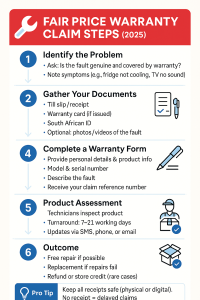When you buy new furniture, a household appliance, or electronics, the last thing you want is to deal with a faulty product. Yet, many South Africans face this problem every year and often don’t know how to claim their warranty rights. The Fair Price warranty policy 2025 is designed to give customers peace of mind by offering protection against defects and ensuring reliable after-sales support. Understanding how this policy works can save you frustration, time, and unnecessary costs.
This guide explains everything you need to know about Fair Price product warranties, repairs, and replacements. You’ll learn what is covered, how to claim a warranty, what documents you need, and how to protect your rights under South African law. By the end, you’ll feel empowered to use your warranty confidently whenever you face problems with a Fair Price purchase.
Understanding the Fair Price Warranty Policy 2025
Every product you buy from Fair Price comes with a warranty that protects you against certain risks. A warranty is essentially a promise from Fair Price or the manufacturer that the product will perform as expected for a specific period.
Standard coverage: Most products are covered for six to 24 months, depending on the type of item.
Store warranty vs manufacturer warranty: The Fair Price warranty policy applies to all items sold in-store, while some manufacturers provide their own, often longer, warranties.
Policy exclusions: Not everything is covered. Warranties usually exclude accidental damage, misuse, wear and tear, or unauthorised repairs.
The Fair Price warranty policy 2025 ensures that if your new product has a factory defect or fails within the warranty period, you won’t have to carry the financial burden of fixing or replacing it.
What is Covered and What is Not
Customers often assume that every type of damage is automatically covered, but that is not the case. Understanding the scope of coverage is essential.
Covered under Fair Price warranty:
Manufacturing defects.
Electrical faults in appliances and electronics.
Mechanical breakdowns.
Structural issues in furniture within the warranty period.
Not covered under Fair Price warranty:
Accidental damage (e.g., dropping a TV).
Misuse or negligence (e.g., using an appliance incorrectly).
Normal wear and tear (e.g., fabric fading, scratches).
Damage caused by unauthorised repairs or alterations.
Example: If your fridge motor fails within six months, that is covered. But if the failure is due to a power surge and you weren’t using a surge protector, it won’t be covered.
Duration of Warranties at Fair Price
Different product categories carry different warranty durations. Customers should always check the receipt or warranty slip to confirm.
Appliances: 12–24 months, covering major parts like motors and compressors.
Electronics: 6–12 months, depending on the brand and model.
Furniture: 12 months, mainly for structural integrity (e.g., broken frames).
Some manufacturers extend warranties beyond Fair Price’s coverage. For example, a washing machine may have a 12-month Fair Price warranty but a three-year motor warranty from the manufacturer.
Difference Between Manufacturer and Fair Price Warranties
When buying electronics or appliances, you may notice both a store warranty and a manufacturer warranty.
Fair Price warranty: Covers issues within a shorter timeframe (usually 6–12 months). You return the product to the store for repairs or replacements.
Manufacturer warranty: Often longer (12–36 months). You deal directly with the manufacturer’s authorised service centre.
Example: A Samsung TV bought from Fair Price carries a 12-month store warranty, but Samsung may cover it for 24 months. After the first year, you’ll need to contact Samsung directly.
Knowing when to contact Fair Price versus the manufacturer can save time and frustration.
Step-by-Step Guide to Claiming a Warranty at Fair Price
Making a warranty claim can feel overwhelming if you’ve never done it before, but the process at Fair Price is designed to be as straightforward as possible. By following the correct steps, you avoid unnecessary delays and give yourself the best chance of a smooth resolution.
Here’s a detailed breakdown of what you should do:
Step 1: Identify the problem
Before heading to the store, make sure the issue you’re experiencing falls within the warranty’s scope.
Check your product manual to rule out simple errors (e.g., a fridge not cooling because the thermostat is set incorrectly).
Consider whether the issue is a manufacturing defect (covered) or due to misuse/accidental damage (not covered).
If you’re unsure, note down the symptoms (e.g., “the washing machine does not spin” or “the TV screen shows no picture”).
Step 2: Gather your documents
Having the correct paperwork speeds up the process significantly. Fair Price will almost always require:
Proof of purchase: Your original till slip or sales receipt. Without this, claims are much harder to process.
Warranty card or certificate: If provided at the time of purchase.
Valid South African ID: To confirm your identity and match the purchase.
Optional supporting evidence: Photos or short videos showing the fault can help technicians understand the problem more quickly.
Tip: Keep all receipts for major purchases in a safe folder or scan them into digital storage for backup.
Step 3: Visit the nearest Fair Price branch or contact customer service
You can start your warranty claim in two ways:
In-store: Go to the Fair Price branch where you bought the item or the nearest branch to your home. A customer service consultant will guide you through the process.
By phone/email: Contact Fair Price’s customer service hotline or send an email with your purchase details. This is useful if you live far from a branch.
When explaining the issue:
Be clear and specific about the fault. Avoid vague statements like “it doesn’t work.”
Provide your proof of purchase details upfront.
Ask about turnaround times so you know what to expect.
Step 4: Fill in a warranty claim form
In-store, staff will provide a warranty claim form. This document is important because it records:
Your contact details (phone number and email).
Product details (model number, serial number, date of purchase).
A description of the problem.
A reference or case number assigned to your claim.
Always keep a copy of this form or note down your claim reference number. You’ll need it when following up on the status of your repair or replacement.
Step 5: Wait for product assessment
Once the claim is logged, Fair Price will send the faulty product to its technicians or an authorised repair centre. During this stage:
A qualified technician will inspect the item to confirm whether the fault is covered under the warranty.
This process can take anywhere from 7 to 21 working days, depending on the product and availability of parts.
Customers are usually notified by SMS, phone call, or email once the assessment is complete.
Tip: Don’t dispose of packaging until you’re sure your warranty is accepted. Some items may need to be returned in original boxes for safe transport.
Step 6: Receive the outcome
After assessment, Fair Price will inform you of the result. There are usually three possible outcomes:
Repair at no cost: If the fault is minor or repairable, the product will be fixed free of charge.
Replacement: If the item cannot be repaired or the same fault happens repeatedly, you may receive a new product of the same or similar model.
Refund or store credit: In rare cases where neither repair nor replacement is possible, you may be offered a refund or credit to use in-store.
Always check whether the repaired or replacement item comes with a new warranty period. In most cases, repairs continue under the original warranty timeline, while replacements may include a fresh warranty.

Documents Needed for Warranty Claims
To avoid delays, make sure you bring the right paperwork.
Original receipt or till slip.
Warranty certificate (if provided).
Valid South African ID or contact details.
Photos of the faulty product (optional but helpful).
Infographic suggestion: “Documents Needed for Warranty Claim” checklist.
How Fair Price Repairs and Replacements Work
Once your warranty claim has been logged and accepted, Fair Price follows a structured process to ensure the problem is resolved fairly and efficiently. While the exact timeline can vary depending on the product type and the nature of the fault, most claims follow the same pathway.
1. Product Assessment
The first step after logging a claim is an assessment by qualified technicians.
The product is sent to a Fair Price-approved service centre or authorised repair partner.
Technicians inspect the fault to confirm whether it is covered under warranty. For example, a faulty compressor in a fridge is usually covered, but damage caused by incorrect installation may not be.
This stage is crucial because it determines whether you will receive a repair, replacement, or refund.
Customer tip: Always request written confirmation that your product has been checked in. This protects you if the item is misplaced in transit.
2. Repair Process
If the technicians confirm that the fault is repairable, the product is sent for servicing.
Repair turnaround time: Usually 14–21 business days, but this can vary depending on the availability of spare parts.
If parts need to be ordered from overseas, the repair may take longer.
Once the repair is complete, you’ll be notified to collect the product or arrange delivery back to your branch.
Important: The repaired product continues under the original warranty period. For example, if your TV had six months left on its warranty when repaired, the remaining coverage does not reset.
3. Replacement
If the technicians find that repairs are not possible, or the same fault occurs repeatedly, Fair Price will replace the product.
Replacements are usually for the same model if stock is available.
If the exact model is no longer in stock, you may be offered a similar or equivalent model with comparable features and value.
Customers typically receive a replacement within 7–10 days after assessment approval.
Customer tip: Always check whether the replacement product comes with a fresh warranty period or whether the original warranty continues. Policies may differ depending on the product category.
4. Refunds or Store Credit
Refunds are the last resort and are only issued in limited cases:
When neither repair nor replacement is possible.
When the same product has failed multiple times within the warranty period.
When a product line has been discontinued with no suitable replacement option.
Refunds are generally processed as store credit, but in exceptional cases, a full cash refund may be authorised. Store credit allows you to choose a new product while retaining the original value of your purchase.
5. Communication and Updates
Throughout the process, Fair Price keeps customers updated via:
SMS notifications.
Phone calls from customer service.
Email updates with claim progress.
Always keep your claim reference number safe. You will need it whenever you call or email for updates. Without it, staff may take longer to trace your case.
Pro Tip: If you haven’t received updates within the stated turnaround time, follow up with customer service using your reference number. Persistent but polite communication often speeds up the process.
Tips to Protect Your Warranty
Many warranty claims are rejected because customers unintentionally void the terms. Protect your rights with these tips:
Keep all receipts and warranty slips in a safe place.
Do not attempt self-repairs or use unauthorised service providers.
Use surge protectors for electronics to prevent damage from power outages.
Follow care and usage instructions provided in the product manual.
Register your product with the manufacturer when possible.
By following these steps, you’ll avoid losing out on warranty benefits.
Customer Scenarios and Examples
To make the warranty process clearer, here are three realistic examples:
Scenario 1: Faulty fridge
Thandi bought a fridge from Fair Price. After three months, the motor stopped working. She took her receipt and warranty card to her nearest branch. The fridge was repaired at no cost within 18 days.Scenario 2: Lost receipt
Sipho purchased a TV but lost the receipt. His warranty claim was delayed because proof of purchase was missing. Eventually, Fair Price traced the sale using his ID number, but the process took longer.Scenario 3: Misuse of product
Naledi returned a microwave that stopped working. Technicians found burn marks from placing metal objects inside. Her claim was rejected because misuse is not covered.
These examples show the importance of keeping documents safe and using products correctly.
Fair Price Customer Service: Getting Help
When problems arise, knowing where to turn makes a big difference.
In-store helpdesk: Available at all branches. Staff assist with warranty forms and claims.
Customer care hotline: Call centre staff guide you through the process and log complaints.
Email support: For written records and attachments like proof of purchase or product photos.
Tip: Contact customer service during weekdays and working hours for faster responses. Always note the name of the representative you spoke to.
Read more: Top 10 Budget-Friendly Headboards in 2025: Best Prices for Stylish Bedrooms
South African Consumer Rights and the CPA
The Consumer Protection Act (CPA) protects all South Africans when buying goods. A key part of this law is the six-month implied warranty. This means:
All goods must be safe, reliable, and durable.
If a product fails within six months, the consumer has the right to return it for a repair, replacement, or refund.
Retailers cannot refuse a return if the product is defective, regardless of store policy.
Fair Price’s warranty policy is aligned with the CPA, offering additional peace of mind beyond the minimum legal requirements.
Frequently Asked Questions (FAQ)
How long is the Fair Price warranty?
Most products come with a warranty of six to 24 months, depending on the item.
What happens if I lose my receipt?
Claims may be delayed. Always keep proof of purchase, but Fair Price may trace sales using your ID.
Can I exchange a faulty product instead of repairing it?
Yes, if the product cannot be repaired. Otherwise, repairs are prioritised.
Do I get a loan unit while waiting for repairs?
No, Fair Price does not provide loan units during the repair process.
Are extended warranties available?
Some products qualify for extended manufacturer warranties. Always check at the time of purchase.
What should I do if my product stops working after the warranty expires?
Once the warranty period ends, repairs become the customer’s responsibility. However, you can still contact Fair Price for advice on service centres or spare parts.
Does the warranty cover accidental damage?
No. Damage from accidents, misuse, or neglect (e.g., dropping a TV or spilling liquids on a device) is not covered.
Can someone else claim on my warranty?
Yes, but they must present the original proof of purchase and your authorisation (such as a signed note or copy of your ID).
How do I know if my claim has been approved?
Fair Price will send you an update by SMS, phone, or email once the technician’s assessment is complete. Always keep your claim reference number for tracking.
What happens if my replacement product is out of stock?
If the same model is unavailable, Fair Price will offer a similar product with equivalent features or provide store credit of the same value.
Also check: Ackermans Refund & Exchange Policy Explained
The Fair Price warranty policy 2025 is designed to protect your household purchases, ensuring you don’t face unnecessary costs when products fail unexpectedly. By understanding what is covered, keeping your documents safe, and following the correct steps, you can use your warranty with confidence.
Whether you’re buying a fridge, a sofa, or a new television, remember that warranties are there to protect you. Stay informed, follow the process carefully, and contact Fair Price customer service whenever you need assistance.
For more details on store policies, visit your nearest Fair Price branch or check the official website.










